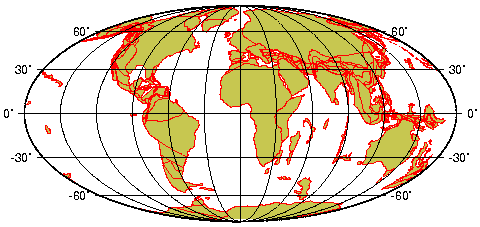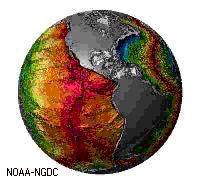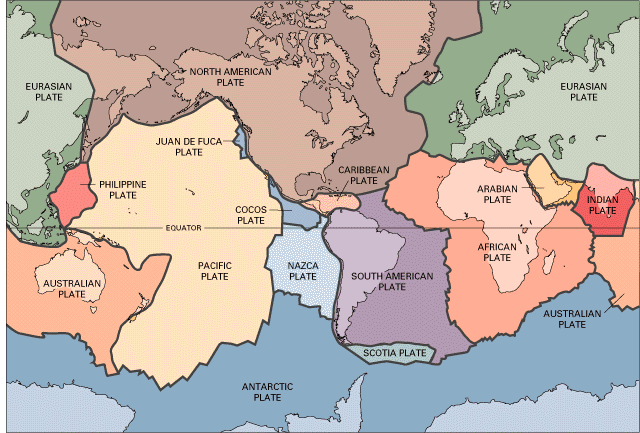Evolving Earth: Plate Tectonics
In this lecture, we wish to learn:
Jump to: [Introduction] [Lithosphere-Asthenosphere] [Thermal Boundaries] [Chemical Boundaries] [Origin of Earth's Layering] [Ocean Floor] [Prediction] [Paleogeography] [Summary] [Self-Test]Introduction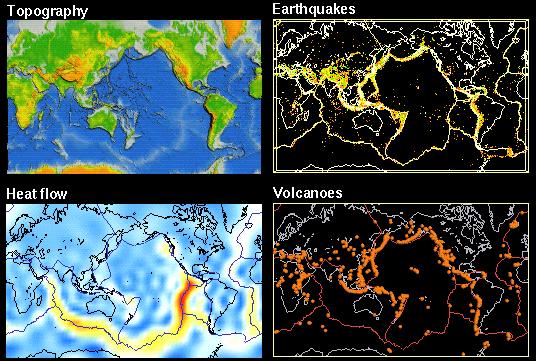
These four views show several characteristics of Earth that we have discussed so far (and one, heat flow, that we will get to later). Topography characterizes the continents and ocean basins, whereas earthquakes and volcanoes show the location of today's geologic activity. You immediately notice that neither earthquakes nor volcanoes are randomly distributed, but that they occur in narrow belts. These belts always coincide with plate boundaries, which provides the critical clue to understanding geologic processes of Earth and the theory of plate tectonics. Plate tectonics, a concept that has revolutionized thinking in the Earth sciences in the last 25 years, combined the ideas of continental drift (originally proposed in the 1910s by Alfred Wegener) and sea-floor spreading (suggested originally by Harry Hess in the early 1960s).
Lithosphere-AsthenosphereThe velocity of energy waves is a function of the density of the medium through which they pass. For example, sound waves in air travel slower than sound waves in water. Thus, looking at the velocity of energy waves that pass through the Earth, and especially their variations with depth, allows us to get a first order idea of the density structure of the Earth. We have ample access to large energy waves for this study. The positive side of otherwise destructive earthquakes is the propagation of natural energy waves through the Earth. Elsewhere we examine the nature of earthquakes in more detail, but here we use them only as sources of energy release. In this context, earthquakes are no different from explosions.At the source of an earthquake, several types of energy waves are generated. Surface waves are responsible for the damage that is associated with earthquakes, but they have limited lateral extent. In contrast, body waves can be recorded all around the world. There are two types of body waves that we will consider: compression waves and shear waves. Compression waves travel through material by pushing atoms together for a brief moment, after which they return to their original spacing. The brevity of the process implies that the material is not permanently changed, which is what we call elasticity. Pulling and elastic bend is a perfect analogy of this process, except that the elasticity of rocks is much less. A nice experiment to show the propagation of compression waves is through a large slinky. We briefly move our hands sideways to generate an area of compression, which then travels away from us until reaching the other end of the slinky. Shear waves behave differently, as
the relative motion of atoms from a passing shear wave is like rubbing
your hands. Once the wave passes, the atoms return to their original state,
so in spite of the different motion, shear waves are also elastic waves.
You can generate the appearance of a shear wave by quickly moving your
hand up and down while holding a rope. Just like in the previous example,
the rope is only spatial analog. The atoms that make up the rope are not
actually shearing, but the body itself describes the shear wave function. Another surprising change occurs at ~2900 km depth. Here we find that compression waves actually decrease in velocity and that shear waves even have a velocity of zero! This major change in the Earth was first recognized in the middle of the 20th century, and named the Gutenberg discontinuity after its discoverer. The Gutenberg discontinuity, or 2900 km discontinuity separates the Earth's core from the Earth's mantle. What does a shear wave velocity of zero mean in terms of material properties? Shear waves are transmitted by the lateral displacement of atoms in materials. But if these atoms are not bound so that they return to the original configuration after the wave passes, there will be no shear wave transmission. Materials with such atomic properties are fluids and gases, where the atoms are loosely or not connected. So, the material below the 2900 km discontinuity must be in a form other than solid. Note that the terms solid, liquid and gas are used relative to time frames of elastic wave propagation, meaning in terms of seconds and minutes. Later we will see that even solids may behave like liquids in geologic time units, which are measured in millions of years. For elastic wave propagation, the time-dependent properties are similar to our daily time units. The properties of compressive waves across this boundary tells us that liquid rather than gas is the form of the material at these depths. Finally, we see another jump in properties at ~5150 km depth, which means that the core itself is also layered. When we compare the properties of elastic waves through a material made primarily of Fe (like iron meteorites), it turns out that its characteristics match those of the core quite well. The variation in velocity of shear and compressive waves is fully explained by a liquid outer core and a solid inner core made up mostly of Fe, some Ni, and some heavily debated lighter elements such as H, O and S. Given that we know the thickness of the Earth's layers, 2900 km for the mantle and 4080 km for the core, and ignoring the Earth's thin outer layer (crust, ~50 km), we can determine the relative volumes of these layers. This shows that the volume of the mantle is more than 5x that of the core, even though the core has a much greater radius. If 20% of the earth consists of material with density 7500 kg/m3 and the average Earth is ~4300kg/m3, then the average density of the remaining 80% must be ~3500 kg/m3. The required density shows that surface rocks are not sufficiently dense to represent the mantle as a whole, but the average mantle density agrees quite well with that of stony meteorites (in particular the regular chondrite type). So the layers of the Earth the mantle and the core are reasonable approximated by the properties of stony and iron meteorites, respectively. The only question remaining is the reason for a core that is both molten and solid. The answer from this comes from high pressure-high temperature experimental work, and the realization that temperature in the earth increases with depth. This heat is a remnant of Earth's initial formation and heat from gravitational attraction (recall the force in stars that drives fusion). Pressure increase drives materials into a solid form, whereas temperature increase drives material toward a liquid (or gaseous) form. Perhaps you have learned about phase equilibria in a chemistry course, and we get into some of the details below. For now, the interplay between temperature and pressure is responsible for the state of the core. An Fe-alloy at temperature and pressure conditions representative for the outer core will be in molten state, whereas P-T (pressure-temperature) conditions in the inner core region make a solid. Two interesting notes. As the Earth has been cooling since its formation at ~4.56 Ga, the solid part of the core should be growing. Secondly, the interaction between the solid and liquid parts of the core create an important property of the earth: a magnetic field. Thermal BoundariesThe gross structure of the Earth can be determined from the propagation of elastic waves that are generated from earthquakes. If we look at the wave propagation in more details, we are actually able to recognize second-order variations that define layers in the outer 700 km and lateral variation in properties that define temperature heterogeneties in the mantle. Modern studies of seismic wave propagation through the mantle have shown small variations in lateral velocities that are related to variations in temperature of otherwise identical chemical materials. Areas characterized by relatively slow wave velocities represent hotter material, whereas regions with faster velocities are relatively cool. Doing such mantle tomography for the entire Earth produces a 3D scan of structures in the mantle.Let's first look at the role of temperature. Solids, liquids and gases are three states of matter, with temperature increasing in that order. Density, on the other hand, typically decreases from solid to liquid to gas. Let's first look at H2O (water). Below 0C, H2O occurs a solid, called ice. Between 0 and 100C, H2O is the familiar liquid, water, that is used in the preparation of your favorite drink. Above 100C, H2O occurs in the form of a gas, called water vapor. The Celsius temperature scale is, in fact, based on these states of H2O. However, if you boil water on the top of a high mountain, you will find that the transition from water to vapor occurs at a lower temperature than 100C. The reason is that the state of matter is a function of temperature AND pressure, not just temperature. On the top of the mountain the atmospheric pressure is less than at sea level, so it can reach the gas state more easily. We need not worry too much about liquid-gas states in Earth's interior, so we turn to liquid-solid states. Unfortunately, water is not a great example when it comes to the water-ice transition. Ice can actually turn to water under increasing pressure. This means that pressure promotes the formation of water from ice, whereas most compounds (including rocks) demonstrate the opposite effect: pressure increase promotes the solid state. By the way, the reason why ice skating works so well is exactly this special property of the ice-water transition. A thin film of water is formed at the base of the skate where it presses on ice, which promotes gliding (=skating). Another special effect that relates to the pressure dependence of the ice-water water transition, is that ice takes up more volume than the same number of molecules in the liquid state. If you have ever placed a drink in the freezer and later retrieved a cracked bottle, you can now know what to blame for this effect. Most compounds move toward the solid state when pressure increases, whereas they move toward the liquid state when temperature increases. Since both temperature and pressure increase with depth in the Earth, there is a delicate interplay between these two effects. As temperature increases with depth, the corresponding pressure increase is not everywhere sufficient to keep all mantle material in a solid state. Locally, some melting may occur, which will have an immediate effect on elastic wave properties. This reduction in velocity from traveling through less dense material occurs in what is called the Earth's Low-Velocity Zone (LVZ). In contrast to the Moho, this boundary is thermal in origin, rather than chemical. Below this region, pressure increase pushes the material back into the solid state, which is seen by an increase in velocity. This relatively cool area above the low-velocity zone is a mechanically strong layer, called the lithosphere (meaning strong as a rock). The area below the LVZ is mechanically weaker, and is called a the asthenosphere (meaning no strength). Chemical BoundariesThe velocity structure in the outermost part of the Earth represents a combination of chemical and temperature variations. Above we already explored temperature variations. Recall that the relationship between density and chemistry is essentially one of number of nuclear particles per volume, so denser material in the Earth must represent different chemistry. A major chemical boundary was recognized in the mid-20th Century by Mohorovicic, as determined by a sudden increase in wave velocity. This boundary, called simply the Moho, separates a thin outermost layer of Earth that we call the crust, from the underlying layer, the mantle. The nature of this boundary is chemical in origin, like the Gutenberg boundary that separates the mantle from the core.Origin of Earth's LayeringThe origin of Earth's initial differentiation between core and mantle (chemical boundary) resides in the accretionary processes of planet formation. The core formed very early in the planet's history (<50 my. after initial accretion), but the principles are covered in another section. The origin of the lithosphere has already been explained as a consequence of temperature variation of the Earth. Thus, we now concern ourselves primarily with the origin of the crust -- particularly the contrast between granitic and gabbroic (or basaltic) crust.Earth's crust is the thin shell that lies atop the thick mantle, and it is reasonable to assume that the crust is extracted from the mantle, especially the outermost part of the mantle. An interesting approach to understanding this process is to look at some tracer element. We'll use the element K (Potassium) for this purpose, which is concentrated in the outermost layers. The K content of ocean crust is ~0.1%, whereas the K content of continental crust is ~1%. As there is 10x more K in continental crust, we would need 10 units of oceanic material to make one unit of continental material. Using the average dimension of ocean and continental crust we derived earlier (70% ocean, with average thickness of 8 km; 30% continent with average thickness of 40 km), we find that the ratio of continental crust/oceanic crust is slightly greater then 2. Thus, since we have twice as much continental crust, we need 20 times today's oceanic crust to create continents. Where would all this come from? You'll see later that today's ocean floor is less than 200 Ma old, with an average age of >100 million years, whereas the continents are as old as 4 Ga. So, 20 cycles of oceanic crust would take <2 by. of Earth's 4.56 Ga history. The big question is the process that would allow such a scenario. The explanation lies in Earth's geologic recycling program, called plate tectonics. Ocean FloorThe ocean floor in particular provides key information. It is not a smooth surface, but is host to large topographic variation, from mountains that rise above sea level (e.g., Hawaii) to trenches that extend 11 km below sea level (e.g., Marianas trench). The ocean basins also host the world's largest mountain belt, which is most below sea level. These ocean ridges are a system of narrow submarine mountains and canyons that are present in all of the major oceans. Along these ridges, the ocean floor is being continuously pulled apart. Hot magma rises to the surface and continuously forms new oceanic crust. The heat associated with this process is nicely illustrated by the heat flow map in figure 1. Ocean ridges themselves are offsets along (transform) faults, which are the main sites of ocean floor earthquakes. Crucial
to accepting the concept of steadily moving plates was the discovery in
the 1950s that the Earth's magnetic field has reversed its polarity hundreds
of times in the last 100 million years and many more times before that.
As lava solidifies at ocean ridges, it becomes magnetized according to
the polarity of the Earth's magnetic field when magnetic minerals pass
through a particular temperature range (the Curie point; ~480C in magnetite).
If the field's polarity is reversed, the basalt is magnetized in an opposite
sense. As the ocean floor moves away from the ridges, these magnetized
strips of rock are carried away on either side like a conveyer belt. This
process is remarkably similar to that used in a magnetic tape recorders. Crucial
to accepting the concept of steadily moving plates was the discovery in
the 1950s that the Earth's magnetic field has reversed its polarity hundreds
of times in the last 100 million years and many more times before that.
As lava solidifies at ocean ridges, it becomes magnetized according to
the polarity of the Earth's magnetic field when magnetic minerals pass
through a particular temperature range (the Curie point; ~480C in magnetite).
If the field's polarity is reversed, the basalt is magnetized in an opposite
sense. As the ocean floor moves away from the ridges, these magnetized
strips of rock are carried away on either side like a conveyer belt. This
process is remarkably similar to that used in a magnetic tape recorders.
Based on these magnetic strips as
evidence of plate movement, it became obvious that the Earth's surface
consisted of a mosaic of plates that were continually jostling
one another. The rate at which they move ranges from 1-15 cm/year, which
means 10-150 km/my. If the Earth is not to inflate like a balloon by the
creating new material at the ocean ridges, then crust must be destroyed
elsewhere at the same rate. The balance occurs where plates move under
(subduction zones) and against (collision zones) one another. Thus there
are three types of plate boundaries:
divergent, convergent and transform
boundaries (see figure).
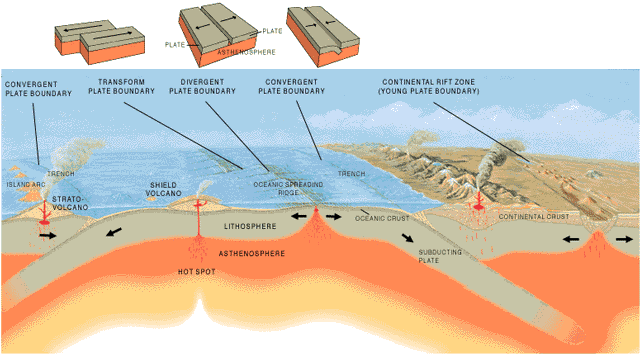 Plate Boundaries How are earthquakes and volcanoes connected with plate tectonics? If we plot the locations of all earthquakes in a ten-year interval (or longer), most are confined to narrow belts that define the boundaries of plates. The type of fault motion associated with these earthquakes defines the type of plate boundary. The interiors of plates are largely free of earthquakes, but there are notable exceptions to this. A major one was the 1811-1812 earthquakes at New Madrid, Missouri, and another was the 1886 earthquake at Charleston, South Carolina. As yet there is no single explanation for these isolated events; perhaps we will have to find alternative mechanisms to plate tectonics. There are four types of seismic zones. The first follows the line of midocean ridges. Activity is low, and earthquakes occur at very shallow depths. The lithosphere is very thin and weak at these boundaries, so elastic strain cannot build up enough to cause large earthquakes. Associated with this type of seismicity is the volcanic activity along the axis of the ridges (for example, Iceland, Azores, Tristan da Cunha). The second type of earthquake is the shallow-focus event unaccompanied by volcanic activity. The San Andreas fault is a good example of this, as is the Anatolian fault in Northern Turkey. In these faults, two mature plates are scraping against one another. The frictional resistance between the plates builds relatively large elastic strains before they are periodically relieved by major earthquakes. Activity does not always occur along the entire length of the fault during any one earthquake. For instance, the 1906 San Francisco event was caused by breakage only along the northern end of the San Andreas fault, and more recent activity along the San Andreas Fault is also in restricted areas. You can imaging that this restricted movement may play a role in further likelihood of earthquakes elsewhere along the zone, which is the basis for one type of prediction. The third type of earthquake is related to the collision of oceanic and continental plates. One plate is thrust or subducted under the other plate so that a deep ocean trench is produced. In the Philippines, ocean trenches are associated with curved volcanic island arcs on the landward plate, for example the Java trench. Along the Peru-Chile trench, the Pacific plate is being subducted under the South American plate, forming the Andes mountains. This type of earthquake can be shallow, intermediate, or deep, according to its location on the downgoing lithospheric slab. Such inclined planes of earthquakes are know as Benioff zones. The fourth type of seismic zone occurs along the boundaries of continental plates. Typical of this is the broad swath of seismicity from Burma to the Mediterranean, crossing the Himalayas, Iran, and Turkey, to Gilbraltar. Within this zone, shallow earthquakes are associated with high mountain ranges where intense compression is taking place. Intermediate- and deep-focus earthquakes also occur and are known in the Himalayas and in the Caucasus. The interiors of continental plates are very complex, much more so than island arcs. For instance, we do not yet know the full relationship of the East African rift system to the broad picture of plate tectonics. PredictionHow can plate tectonics help in earthquake prediction? We have seen that earthquakes occur at three kinds of plate boundaries: ocean ridges where the plates are pulled apart, margins where the plates scrape past one another, and margins where one plate is thrust under the other. Thus, we can predict the general regions on the Earth's surface where we can expect large earthquakes in the future. We know that each year about 140 earthquakes of magnitude 6 or greater will occur within this area, which is 10 percent of the Earth's surface. But on a worldwide basis we cannot say with much accuracy when these events will occur. This is because the processes in plate tectonics have been going on for millions of years. Averaged over this interval, plate motions amount to several millimeters per year. But at any instant in geologic time, for example the year 1977, we do not know exactly where we are in the worldwide cycle of strain buildup and strain release. Only by monitoring the stress and strain in small areas (e.g. the San Andreas fault) in great detail can we hope to predict when renewed activity in that part of the place tectonics arena is likely to take place.Paleogeography: plate distribution over time
Whereas geologically-speaking we are mainly concerned about very short-term changes (tens to hundreds of years) in Global Change, we get a good appreciation of nature's processes and awesome forces by looking at the geologic record. The animation displays the position of the continents over the past 150 Ma, from the breakup of supercontinent Pangea that formed the Atlantic Ocean to today (make your own reconstruction at the ODSN site). Regardless of the changes that will affect us in the next century, the plates will continue their journey. Small as the displacement may seem (the plates move at about the rate that your hair grows), the forces generated are very large and the natural hazards that they produce will remain to be enormous. There's no messing with nature in the long run.
The consequence of this process is the characteristic age variation of the ocean floor, seen in the figure. The youngest rocks (few Ma) are shown in red, whereas the oldest rocks (150-200 Ma) are shown in blue.
Summary The layers of the Earth can be described in terms of their physical properties (e.g., lithosphere and asthenosphere). The behavior of seismic waves is dependent upon the phase of the material as well as its temperature. The patterns of the velocity of seismic waves through the Earth's interior provide us with a physical interpretation of the crust, mantle, and core as well as the location of the boundaries between these layers.The outer layer of the Earth is divided up into several lithospheric plates. Magnetic reversals on the ocean floor helped to develop the theory of ocean floor spreading and, ultimately, the concept of plate tectonics. The processes related to plate tectonics operate over long time scales (millions of years) which is part of the reason that this inherent dynamic nature of the Earth went unrecognized for so long. Understanding the tectonic history of the Earth is crucial in determining the rates of change both on a global and regional scale, the origin and location of many natural hazards and it is also important in predicting what may happen in the future.
All materials © the Regents of
the University of Michigan unless noted otherwise.
|


